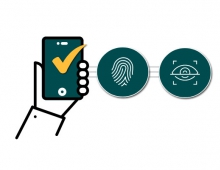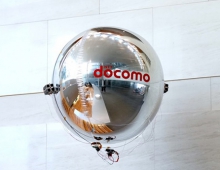
NTT Develops First Multi-application Smart Card in Compliance with GlobalPlatform V2.1 Specifications
Nippon Telegraph and Telephone Corporation (NTT; TSE: 9432) has developed the first smart card in compliance with GlobalPlatform(TM)[1] V2.1 specifications - which are recognized as the de facto standard for multi-application smart card[2] platforms in financial and other fields - and that offers the world's largest memory capacity (1 MB) for this type of card.
Because this card offers far more memory than existing GlobalPlatform cards, it enables installation of several times more application programs, as well as storage of huge volumes of data, such as fingerprints and other biometric information required for biometrics authentication[3].
This card also offers a number of features not available in existing GlobalPlatform cards, such as contactless interfaces[4] and execution functions for programs created in C language[5]. This will enable GlobalPlatform cards to be used in fields that emphasize speed and contactless operation, such as electronic tickets, electronic money, and building entry management cards. With these functions, NTT has created a true multi-application smart card that can be used for a wide range of purposes even outside the financial field.
Background to development
NTT has been developing multi-purpose, multi-application smart cards for several years, and has been a member of GlobalPlatform since the consortium was first established.
The memory capacity for storing downloaded application programs in earlier GlobalPlatform cards was between 16 and 64 KB, so no more than five or six applications could be downloaded. These cards did not have enough memory for applications in non-financial fields to be installed, or to allow the card to be used in biometric authentication. Most of the cards only have contact-type interfaces[6], and in many cases the processing speed was limited, so application programs could only be created in Java language[7]. This meant that it was difficult to use these cards in fields where contactless interfaces and high-speed processing were emphasized, as in the case of electronic tickets, electronic money, and building entry management cards.
Features of this smart card
1) Obtain recognition of the compliace to GlobalPlatform V2.1 specifications for the first time in the world. The compliance to GlobalPlatform V2.1 specificatons - which are recognized as the de facto standard for multi-application smart card platforms - was recognized for the first time in the world.
2) Offers a memory capacity of 1 MB, the highest level of any GlobalPlatform card in the world. By using the large-capacity smart card developed by NTT, this card achieves a memory capacity of 1 MB, which represents the highest level of any card of its kind in the world. More than 300 KB of memory is available for storage of downloaded application programs, making it possible to load five or six times more application programs than in the past. The card can also store over 100 KB of biometrics authentication data at the same time.
(3) Enables use of contactless interfaces, dramatically improving operability for electronic money, building entry management cards, and other applications This new card is compatible with not only ISO7816 contact-type but also ISO14443 Type B contactless interfaces. Processing can be completed by simply approaching the smart card reader/writer, so the operability of GlobalPlatform cards used for electronic money or building entry management improves dramatically. There is no need to distinguish between application programs that use contact or contactless interfaces, which means that existing application programs using contact interfaces can be used with contactless interfaces almost entirely without modification.
(4) Programs in C language can be executed, expanding the range of applications to include electronic tickets and other card types that demand high-speed operations In addition to Java language, which requires a virtual machine, some application programs can be created using C language, which generates formats that can be executed directly by CPU commands. These application programs also offer a function that enables them to be started up first when the card is activated. In this way, NTT has achieved practical processing performance even for application programs that emphasize high-speed operations, as in the case of electronic tickets.
Future developments
From now on, in order to develop this smart card to each field, the smart card platform that offers card application programs download - which is the feature of GlobalPlatform specification, etc. - is improved. For some time now, NTT has been developing the smart card information sharing platform "NICE," [8] which will enable application programs to be downloaded safely to smart cards via the Internet and other networks whenever they are needed. In the future, NICE will enable downloading of application programs to GlobalPlatform cards in order to promote expansion into various fields.
This card also offers a number of features not available in existing GlobalPlatform cards, such as contactless interfaces[4] and execution functions for programs created in C language[5]. This will enable GlobalPlatform cards to be used in fields that emphasize speed and contactless operation, such as electronic tickets, electronic money, and building entry management cards. With these functions, NTT has created a true multi-application smart card that can be used for a wide range of purposes even outside the financial field.
Background to development
NTT has been developing multi-purpose, multi-application smart cards for several years, and has been a member of GlobalPlatform since the consortium was first established.
The memory capacity for storing downloaded application programs in earlier GlobalPlatform cards was between 16 and 64 KB, so no more than five or six applications could be downloaded. These cards did not have enough memory for applications in non-financial fields to be installed, or to allow the card to be used in biometric authentication. Most of the cards only have contact-type interfaces[6], and in many cases the processing speed was limited, so application programs could only be created in Java language[7]. This meant that it was difficult to use these cards in fields where contactless interfaces and high-speed processing were emphasized, as in the case of electronic tickets, electronic money, and building entry management cards.
Features of this smart card
1) Obtain recognition of the compliace to GlobalPlatform V2.1 specifications for the first time in the world. The compliance to GlobalPlatform V2.1 specificatons - which are recognized as the de facto standard for multi-application smart card platforms - was recognized for the first time in the world.
2) Offers a memory capacity of 1 MB, the highest level of any GlobalPlatform card in the world. By using the large-capacity smart card developed by NTT, this card achieves a memory capacity of 1 MB, which represents the highest level of any card of its kind in the world. More than 300 KB of memory is available for storage of downloaded application programs, making it possible to load five or six times more application programs than in the past. The card can also store over 100 KB of biometrics authentication data at the same time.
(3) Enables use of contactless interfaces, dramatically improving operability for electronic money, building entry management cards, and other applications This new card is compatible with not only ISO7816 contact-type but also ISO14443 Type B contactless interfaces. Processing can be completed by simply approaching the smart card reader/writer, so the operability of GlobalPlatform cards used for electronic money or building entry management improves dramatically. There is no need to distinguish between application programs that use contact or contactless interfaces, which means that existing application programs using contact interfaces can be used with contactless interfaces almost entirely without modification.
(4) Programs in C language can be executed, expanding the range of applications to include electronic tickets and other card types that demand high-speed operations In addition to Java language, which requires a virtual machine, some application programs can be created using C language, which generates formats that can be executed directly by CPU commands. These application programs also offer a function that enables them to be started up first when the card is activated. In this way, NTT has achieved practical processing performance even for application programs that emphasize high-speed operations, as in the case of electronic tickets.
Future developments
From now on, in order to develop this smart card to each field, the smart card platform that offers card application programs download - which is the feature of GlobalPlatform specification, etc. - is improved. For some time now, NTT has been developing the smart card information sharing platform "NICE," [8] which will enable application programs to be downloaded safely to smart cards via the Internet and other networks whenever they are needed. In the future, NICE will enable downloading of application programs to GlobalPlatform cards in order to promote expansion into various fields.





















